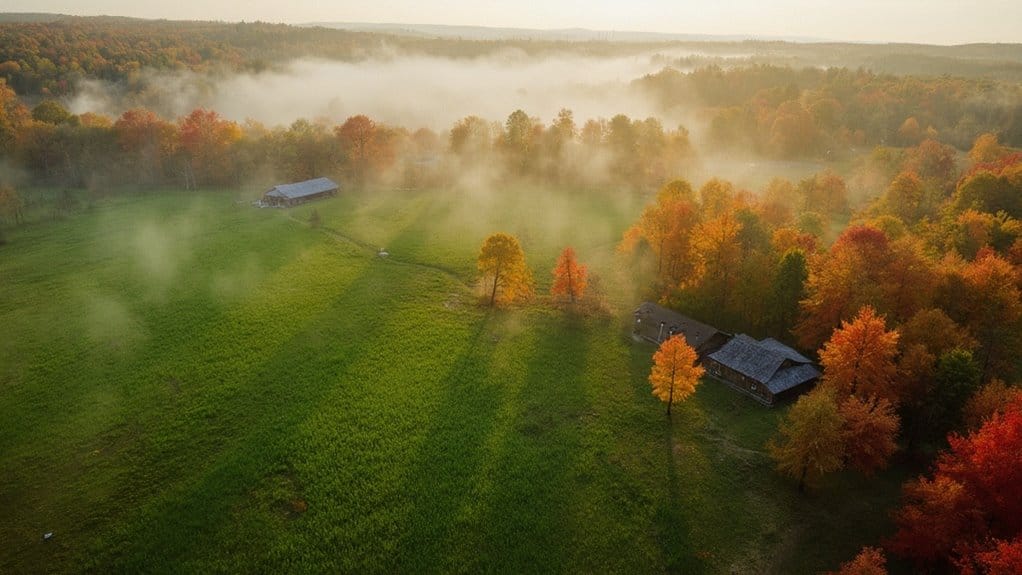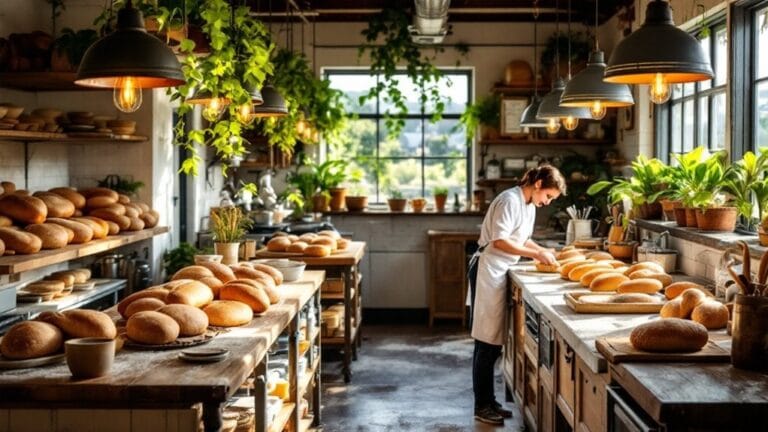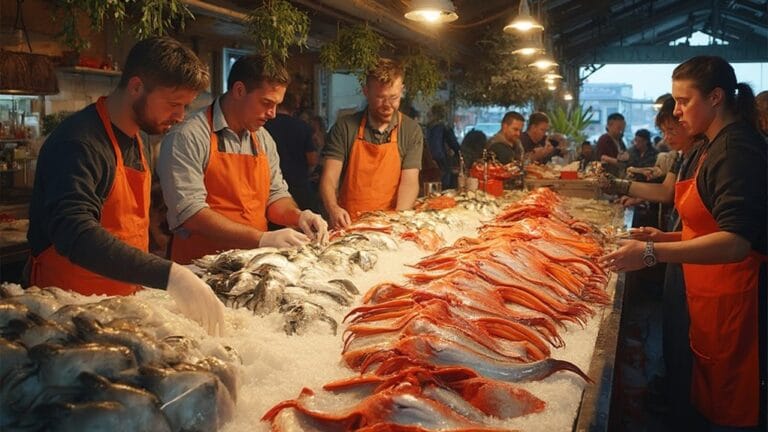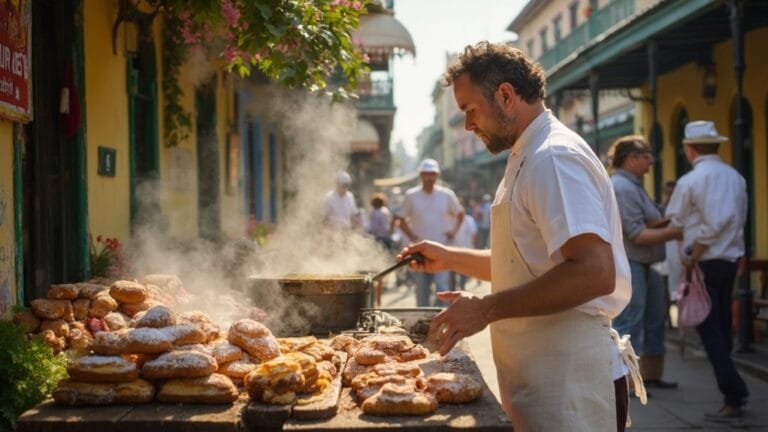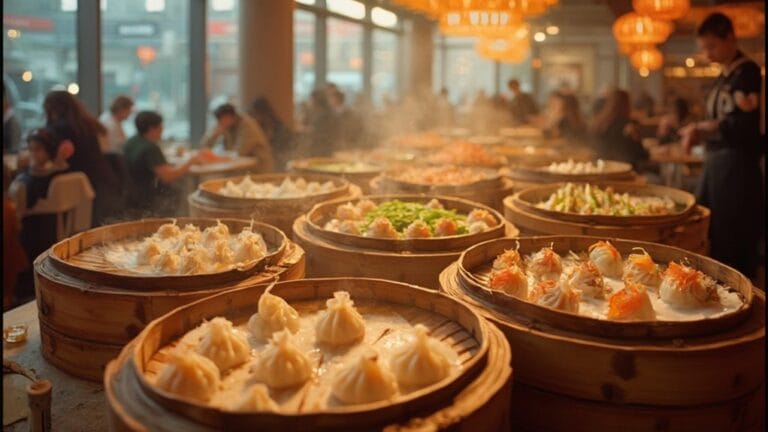If you're craving adventure, Canada's top maple farms are calling your name! At Macphee's Orchard in PEI, you can savor syrup straight from over 600 tapped trees. Wabanaki Maple in New Brunswick serves up barrel-aged syrups with a whiskey twist, while Fulton's Sugar Bush in Ontario offers family-friendly fun like sleigh rides. Don't miss the cozy atmosphere at Temple's Sugar Bush, where wood-fired evaporators add to the charm. Has your mouth started watering yet? Each visit is full of sweet experiences and rich flavors, and there's so much more to discover, too!
Key Takeaways
- Visit Macphee's Orchard in Prince Edward Island for fresh syrup and a farm gate experience with over 600 tapped trees.
- Explore Wabanaki Maple in New Brunswick for unique barrel-aged syrups infused with whiskey and bourbon flavors.
- Enjoy family-friendly activities at Fulton's Sugar Bush in Ontario, which features horse sleigh rides and a large 400-acre farm.
- Participate in hands-on experiences during sugarbush exploration and tasting sessions at Maple Farms' guided tours.
- Attend local maple syrup festivals in early spring for free tastings, demonstrations, and community engagement with local artisans.
Top Maple Farms in Canada
When it comes to the rich tradition of maple syrup production, there's an undeniable charm in exploring the top maple farms across Canada. Picture yourself wandering through Macphee's Orchard in Prince Edward Island, where over 600 trees are tapped, and 90% of their syrup is sold right from the farm gate. You'll feel that personal connection with each tree, almost like you're making a new friend!
Head over to Wabanaki Maple in New Brunswick, where you'll find unique barrel-aged syrups infused with whiskey and bourbon flavors. How cool is that? Then, there's Fulton's Sugar Bush in Ontario, with its sprawling 400 acres of sugar bush, where you can enjoy activities like horse sleigh rides. Did you know that Canada produces 71% of the world's maple syrup? Don't miss Temple's Sugar Bush, which uses traditional wood-fired evaporators in a cozy log cabin setting. The syrup here just tastes like home. If you're craving something a bit different, Maple Rush in Yukon combines local ingredients with syrup from single-forest estates in Quebec. Each of these farms showcases artisanal techniques that make their maple syrup special, inviting you to savor the sweet magic of Canada!
Unique Experiences at Maple Farms

Exploring the unique experiences at maple farms opens up a world of discovery and delight. Imagine strolling through a picturesque sugarbush, learning about the cultural significance of maple syrup while enjoying the sweet scents of the season. Guided tours at places like Sugarbush Maple Farm in Ontario give you a glimpse into the fascinating history and production process that families have cherished for generations. Additionally, you can learn about traditional methods of syrup production that have been passed down through generations.
But it doesn't stop there! You can plunge into hands-on activities, like participating in sap collection during the sugaring season. Picture yourself with your family, collecting sap and then indulging in scrumptious maple taffy served on snow at La Ferme de la Petite Cabane d'la Côte in Quebec. Trust me, it's a sticky, sweet experience you'll never forget!
And if you're lucky enough to visit during Maple Weekends, you'll find free tastings and demonstrations that'll have your taste buds dancing. Plus, you can learn about sustainable practices that these farms are adopting, emphasizing the importance of protecting our environment. So grab your loved ones, and make unforgettable memories at these charming maple farms! You'll leave with a deeper appreciation for this delicious tradition.
Best Provinces for Maple Syrup

Maple syrup production in Canada is a sweet proof of the country's rich agricultural heritage. If you're thinking about the best provinces for maple syrup, you can't overlook Quebec. Producing a whopping 88.6% of Canada's syrup, it's like the syrup capital of the world! Major production areas like Chaudière-Appalaches and Mauricie are bursting with those delicious sap-rich trees. You'll find that Quebec's maple syrup history is deep-rooted, showcasing regional syrup varieties that are simply unmatched. In fact, the province alone produced 60,252,243 kg of syrup last year.
Now, don't forget about New Brunswick and Ontario. New Brunswick contributes 6.6% to Canada's syrup scene, while Ontario adds 4.1%. Both provinces offer unique flavors and experiences. In Nova Scotia, though it's only 0.3%, you might discover some hidden gems, like small farms producing delightful syrups with a personal touch.
Economic Impact of Maple Industry
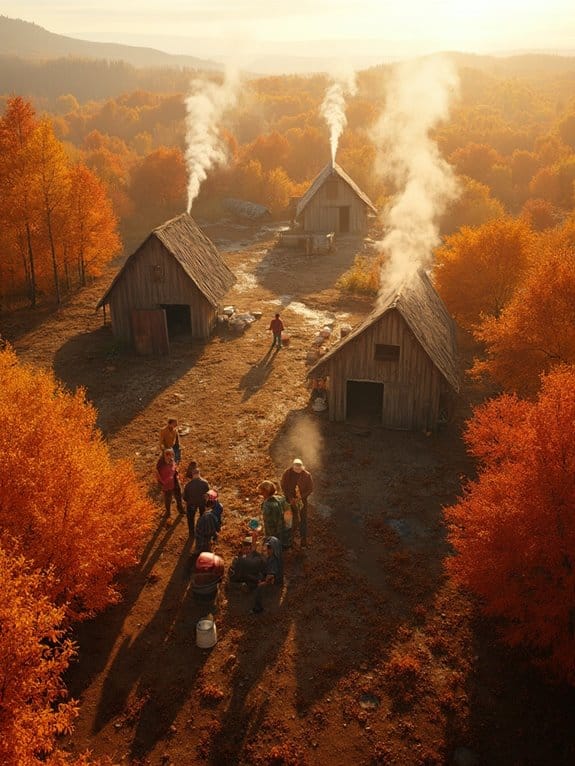
In the heart of Canada's economy, the maple syrup industry plays a significant role, contributing billions to the GDP and creating thousands of jobs. Can you believe that in 2022, it was estimated to contribute over $1.1 billion to the economy? That's a lot of pancakes! With about 12,582 full-time equivalent jobs supported, it's clear this sweet industry is a powerhouse.
Let's talk about market trends and consumer preferences. Maple syrup isn't just for breakfast anymore; it's becoming a sought-after ingredient in gourmet cooking and health-conscious products. People are looking for pure, natural sweeteners, and Canadian maple syrup fits the bill perfectly. The production has skyrocketed, increasing sevenfold in the last 50 years, thanks to tech advancements and passionate producers. Quebec leads the way, producing 92% of Canada's syrup, and even exports to 68 countries!
And get this: for every 100 hectares of public forest used for maple production, the economic returns are staggering—16 times more jobs and 26 times more tax revenue than if it were logged for hardwood. In fact, the total GDP contribution from maple syrup production was approximately $1.133 billion in 2022! So, the next time you're drizzling maple syrup on your waffles, remember, you're supporting a thriving industry!
Sustainable Practices in Maple Production
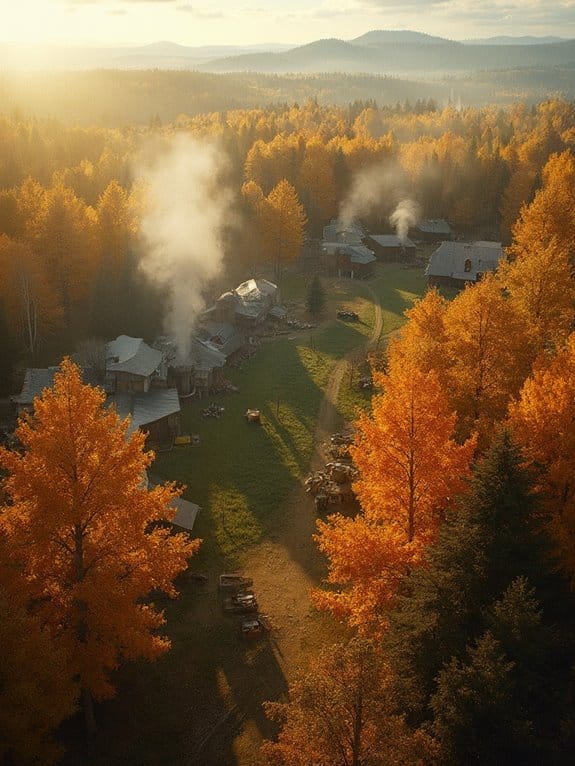
The booming maple syrup industry not only boosts the economy but also emphasizes the importance of sustainable practices in production. You might be surprised to learn how maple farmers use sustainable techniques to protect our precious forests. For instance, they tap trees selectively, ensuring younger trees get a break while older ones provide their sweet sap. This careful approach helps maintain forest health, which is super important for biodiversity. In 2022, Canada produced 17.40 million gallons of maple syrup, showcasing the scale of this sustainable industry.
Farmers also embrace eco-friendly practices, like modern evaporators that use less fuel and emit fewer pollutants. Plus, reverse osmosis systems can remove up to 75% of water before boiling, saving energy and time! In Canada, the government even supports these producers through programs that help upgrade their gear, so they can keep improving.
Research institutions are also getting in on the action, studying ways to reduce carbon footprints and optimize maple syrup production. You might even find organic farms that avoid synthetic chemicals altogether, ensuring purity and sustainability. It's heartwarming to know that when you enjoy that delicious maple syrup, you're also supporting practices that help our environment thrive. So next time you indulge, remember, it's not just sweet—it's sustainable!
Tips for Visiting Maple Farms
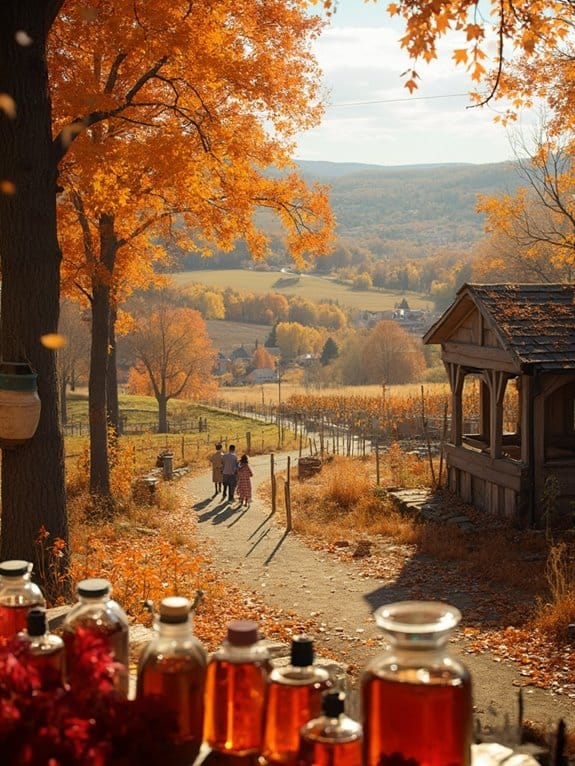
Visiting a maple farm can be a delightful experience, especially during the sugaring season from late February to early April. If you're planning your trip, mid-March is usually a sweet spot for special events, so mark your calendar!
Most farms offer guided tours where you'll learn all about the fascinating history and production process of maple syrup. And don't just stand there—get involved! Many farms let you help collect sap, and you can sample fresh syrup straight from the source. Yum!
While you're there, immerse yourself in some traditional Quebecois meals, take a horse-drawn sleigh ride, or hike through picturesque trails. Don't forget to visit the farm animals; they love the attention! And if you've got a sweet tooth, treat yourself to maple taffy served on snow—it's a must-try. Many farms also feature various activities during festivals(Maple Syrup Festivals and Events) that celebrate the local agriculture and heritage.
Admission fees can vary, so check ahead; some places are even free! Make sure to contact the farm to confirm opening days and book your farm tours. Trust me, you won't want to miss these sweet adventures!
Frequently Asked Questions
What Types of Maple Syrup Grades Are Available?
You'll find four maple syrup varieties: Gold, Amber, Dark, and Very Dark. Each grade reflects different syrup production methods and flavors, enhancing your culinary experiences while ensuring quality and authenticity in every bottle you choose.
How Can I Choose Quality Maple Syrup?
To choose quality maple syrup, you'll want to taste test like a connoisseur! Look for pure ingredients, note the grade for flavor, and explore different maple syrup production methods to find your perfect match.
Are There Vegan Alternatives to Maple Syrup?
Yes, there're several maple syrup substitutes you can try. Coconut nectar, agave nectar, and date syrup are great plant-based sweeteners that provide similar flavors, while brown rice syrup offers a milder taste for your recipes.
Can Maple Syrup Be Used in Baking?
Yes, you can use maple syrup in baking! It offers unique flavor benefits and serves as a great sugar substitute. Just adjust your liquids and oven temperature for perfect results in your delicious treats.
How Should I Store Maple Syrup After Opening?
After opening, store your maple syrup in the refrigerator to maximize its shelf life. Use an airtight container, ensuring it's tightly closed to prevent mold growth and maintain its delicious flavor for up to two years.

